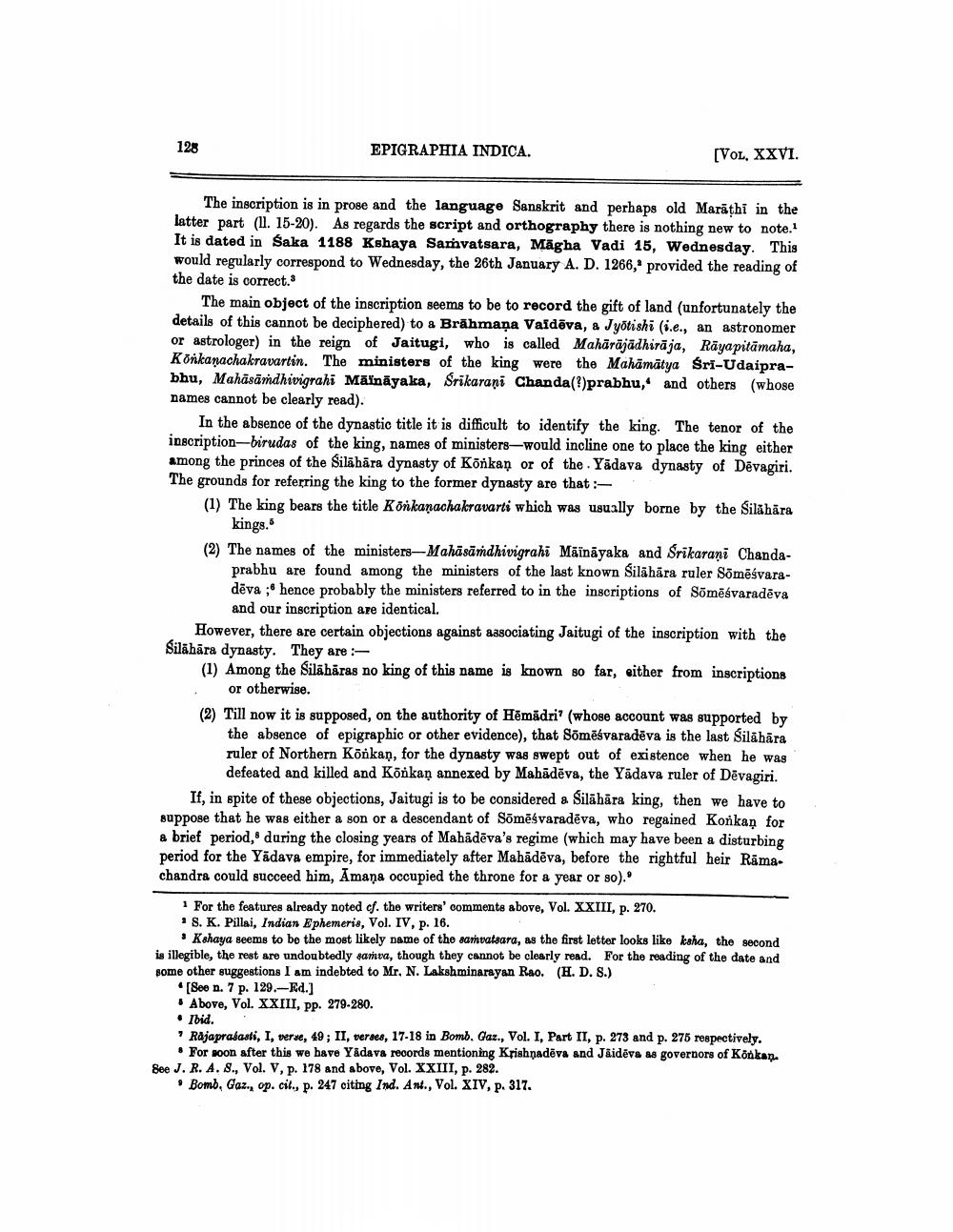________________
128
EPIGRAPHIA INDICA.
[VOL. XXVI.
The inscription is in prose and the language Sanskrit and perhaps old Marathi in the latter part (11. 15-20). As regards the script and orthography there is nothing new to note. It is dated in Saka 1188 Kshaya Samvatsara, Māgha Vadi 15, Wednesday. This would regularly correspond to Wednesday, the 26th January A. D. 1266,9 provided the reading of the date is correct.
The main object of the inscription seems to be to record the gift of land (unfortunately the details of this cannot be deciphered) to a Brāhmaṇa Vaidēva, a Jyotishi (i.e., an astronomer or astrologer) in the reign of Jaitugi, who is called Mahäräjädhiraja, Räyapitāmaha, Korikanachakravartin. The ministers of the king were the Mahāmätya Sri-Udaiprabhu, Mahäsändhivigrahi Māināyaka, Srikarani Chanda(?)prabhu, and others (whose names cannot be clearly read).
In the absence of the dynastic title it is difficult to identify the king. The tenor of the inscription-birudas of the king, names of ministers-would incline one to place the king either among the princes of the Silähära dynasty of Konkan or of the Yādava dynasty of Devagiri. The grounds for referring the king to the former dynasty are that :(1) The king bears the title Konkanachakravarti which was usually borne by the Silähära
kings. (2) The names of the ministers-Mahāsāṁdhivigrahi Māināyaka and Srikarani Chanda
prabhu are found among the ministers of the last known Silahāra ruler Sömēsvaradēva ; hence probably the ministers referred to in the inscriptions of Sömēsvaradēva
and our inscription are identical. However, there are certain objections against aasociating Jaitugi of the inscription with the Silāhāra dynasty. They are : (1) Among the Silāhāras no king of this name is known so far, either from inscriptions
or otherwise. (2) Till now it is supposed, on the authority of Hēmādri? (whose account was supported by
the absence of epigraphic or other evidence), that Sömēsvaradeva is the last Silahāra ruler of Northern Konkan, for the dynasty was swept out of existence when he was
defeated and killed and Konkan annexed by Mahādēva, the Yādava ruler of Devagiri. If, in spite of these objections, Jaitugi is to be considered a Silāhāra king, then we have to suppose that he was either a son or a descendant of Sõmēsvaradēva, who regained Konkan for & brief period, during the closing years of Mahādēva's regime (which may have been a disturbing period for the Yadava empire, for immediately after Mahādēva, before the rightful heir Rāma. chandrs could succeed him, Amana occupied the throne for a year or so).
1 For the features already noted of the writers' comments above, Vol. XXIII, p. 270.
S. K. Pillai, Indian Ephemeris, Vol. IV, p. 16.
• Kahaya seems to be the most likely name of the samvatsara, as the first letter looks like ksha, the second is illegible, the rest are undoubtedly sarua, though they cannot be clearly read. For the reading of the date and some other suggestions I am indebted to Mr. N. Lakshminarayan Rao. (H. D. S.) *[See n. 7 p. 129.-Ed.]
Above, Vol. XXIII, pp. 279-280. • Ibid.
Raja prasasti, I, werde, 49; II, versen, 17-18 in Bomb. Gaz., Vol. I, Part II, p. 273 and p. 276 respectively.
. For soon after this we have Yadava records mentioning Krishnadeva and Jäidēva as governors of Konkan. See J. R. A. 8., Vol. V, p. 178 and above, Vol. XXIII, p. 282.
• Bomd, Gaz., op. cit., p. 247 citing Ind. Ant., Vol. XIV, p. 317.




